Techniques for Measuring and Managing Brand Value Over Time
VerifiedAdded on 2024/04/26
|23
|5764
|435
Report
AI Summary
This management report explores the critical aspects of brand management, emphasizing the importance of effective strategies and techniques for managing brands over time. It highlights the significance of brand management as a marketing tool and differentiates between a brand and a product. The report analyses key components of a successful brand strategy, focusing on building and managing brand equity with examples from Pizza Hut and McDonalds. It examines brand portfolio management, brand hierarchies, and the leveraging of brands both domestically and internationally. Furthermore, the report evaluates various techniques for measuring and managing brand value, underscoring the importance of adapting strategies to maintain brand appeal and achieve long-term sustainability. The student contributed this assignment to Desklib.

Brand management
Page | 1
Page | 1
Paraphrase This Document
Need a fresh take? Get an instant paraphrase of this document with our AI Paraphraser

Contents
Introduction................................................................................................................................3
LO1 Demonstrate an understanding of how a brand is built and managed over time...............4
P1 Explain the importance of branding as a marketing tool and why and how it has
emerged in business practice..................................................................................................4
M1 Evaluate how brands are managed successfully over time using application of
appropriate theories, models, and concepts............................................................................6
P2 Analyse the key components of a successful brand strategy for building and managing
brand equity............................................................................................................................7
M2 Apply appropriate and validated examples within an organizational context.................8
LO2 Analyse how brands are organised in portfolios; how brand hierarchies are built and
managed.....................................................................................................................................9
P3 Analyse different strategies of portfolio management, brand hierarchy, and brand equity
management...........................................................................................................................9
M3 Critically analyse portfolio management, brand hierarchies and brand equity using
appropriate theories, models, and frameworks....................................................................13
LO3 Evaluate how brands are leveraged/extended over time domestically and internationally.
..................................................................................................................................................14
P4 Evaluate how brands are managed collaboratively and in partnership both at a domestic
and global level....................................................................................................................14
M4 Critically evaluate the use of different techniques used to leverage and extend brands
..............................................................................................................................................16
LO4 Evaluate techniques for measuring and managing brand value over time......................17
Page | 2
Introduction................................................................................................................................3
LO1 Demonstrate an understanding of how a brand is built and managed over time...............4
P1 Explain the importance of branding as a marketing tool and why and how it has
emerged in business practice..................................................................................................4
M1 Evaluate how brands are managed successfully over time using application of
appropriate theories, models, and concepts............................................................................6
P2 Analyse the key components of a successful brand strategy for building and managing
brand equity............................................................................................................................7
M2 Apply appropriate and validated examples within an organizational context.................8
LO2 Analyse how brands are organised in portfolios; how brand hierarchies are built and
managed.....................................................................................................................................9
P3 Analyse different strategies of portfolio management, brand hierarchy, and brand equity
management...........................................................................................................................9
M3 Critically analyse portfolio management, brand hierarchies and brand equity using
appropriate theories, models, and frameworks....................................................................13
LO3 Evaluate how brands are leveraged/extended over time domestically and internationally.
..................................................................................................................................................14
P4 Evaluate how brands are managed collaboratively and in partnership both at a domestic
and global level....................................................................................................................14
M4 Critically evaluate the use of different techniques used to leverage and extend brands
..............................................................................................................................................16
LO4 Evaluate techniques for measuring and managing brand value over time......................17
Page | 2
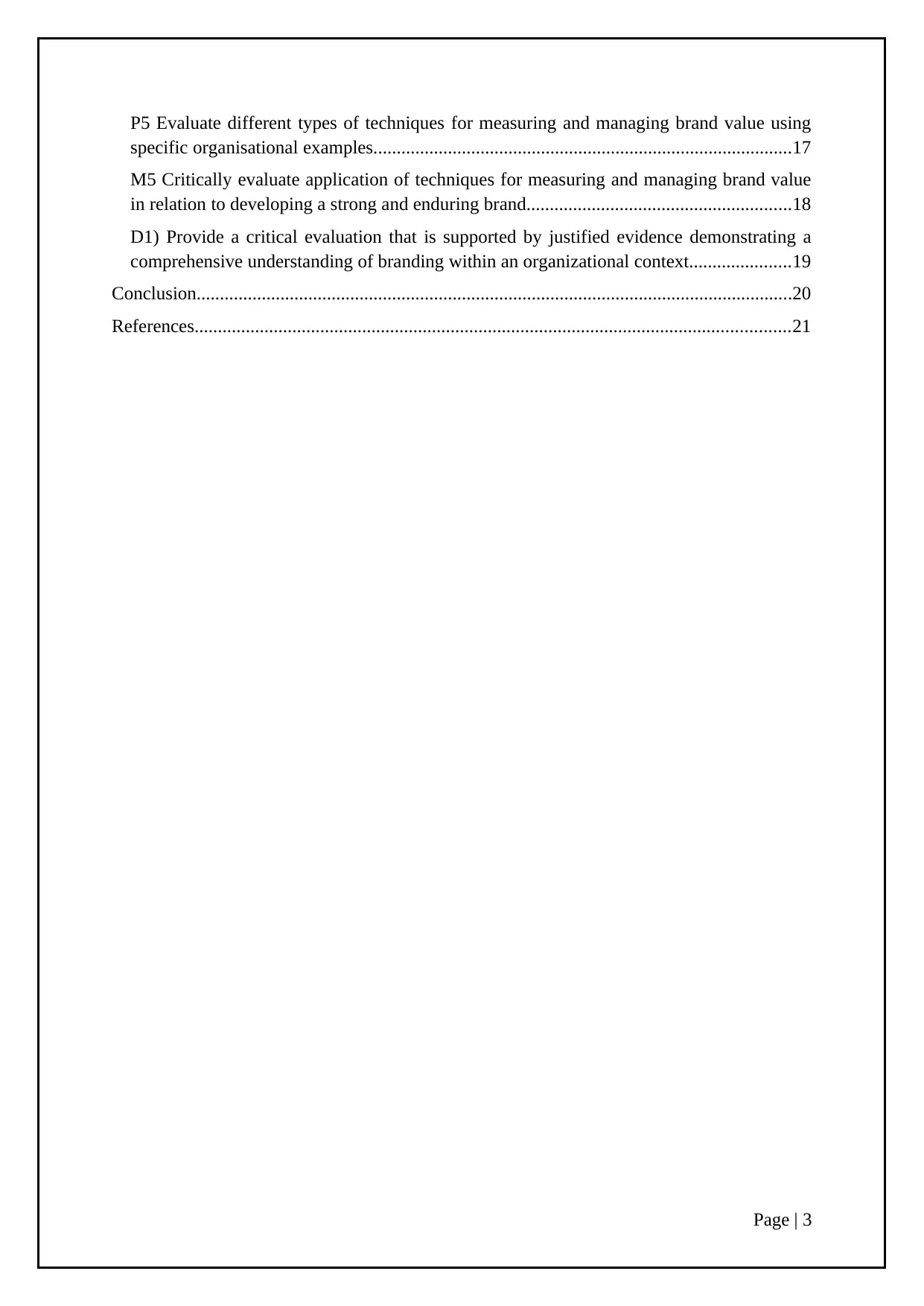
P5 Evaluate different types of techniques for measuring and managing brand value using
specific organisational examples..........................................................................................17
M5 Critically evaluate application of techniques for measuring and managing brand value
in relation to developing a strong and enduring brand.........................................................18
D1) Provide a critical evaluation that is supported by justified evidence demonstrating a
comprehensive understanding of branding within an organizational context......................19
Conclusion................................................................................................................................20
References................................................................................................................................21
Page | 3
specific organisational examples..........................................................................................17
M5 Critically evaluate application of techniques for measuring and managing brand value
in relation to developing a strong and enduring brand.........................................................18
D1) Provide a critical evaluation that is supported by justified evidence demonstrating a
comprehensive understanding of branding within an organizational context......................19
Conclusion................................................................................................................................20
References................................................................................................................................21
Page | 3
⊘ This is a preview!⊘
Do you want full access?
Subscribe today to unlock all pages.

Trusted by 1+ million students worldwide
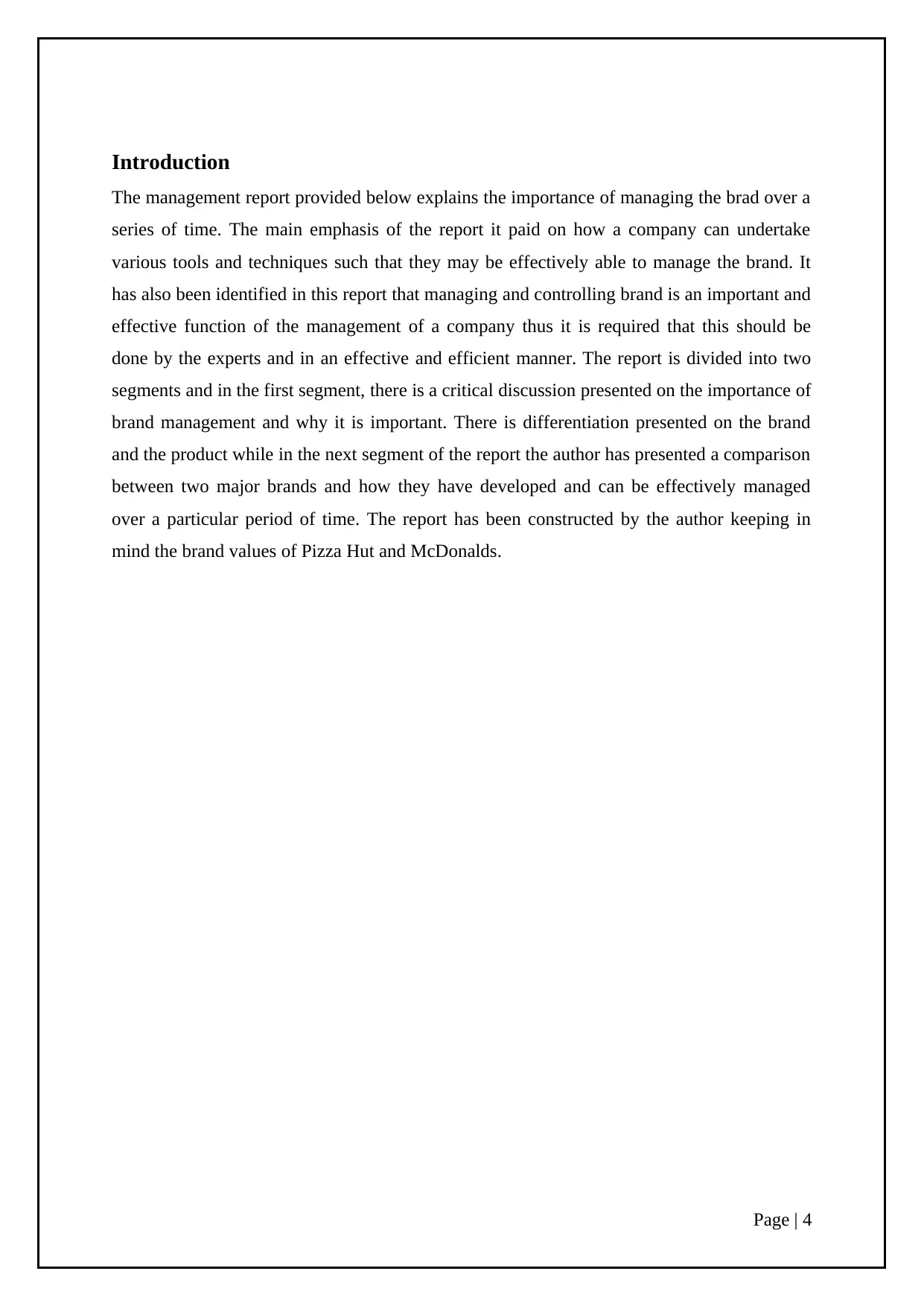
Introduction
The management report provided below explains the importance of managing the brad over a
series of time. The main emphasis of the report it paid on how a company can undertake
various tools and techniques such that they may be effectively able to manage the brand. It
has also been identified in this report that managing and controlling brand is an important and
effective function of the management of a company thus it is required that this should be
done by the experts and in an effective and efficient manner. The report is divided into two
segments and in the first segment, there is a critical discussion presented on the importance of
brand management and why it is important. There is differentiation presented on the brand
and the product while in the next segment of the report the author has presented a comparison
between two major brands and how they have developed and can be effectively managed
over a particular period of time. The report has been constructed by the author keeping in
mind the brand values of Pizza Hut and McDonalds.
Page | 4
The management report provided below explains the importance of managing the brad over a
series of time. The main emphasis of the report it paid on how a company can undertake
various tools and techniques such that they may be effectively able to manage the brand. It
has also been identified in this report that managing and controlling brand is an important and
effective function of the management of a company thus it is required that this should be
done by the experts and in an effective and efficient manner. The report is divided into two
segments and in the first segment, there is a critical discussion presented on the importance of
brand management and why it is important. There is differentiation presented on the brand
and the product while in the next segment of the report the author has presented a comparison
between two major brands and how they have developed and can be effectively managed
over a particular period of time. The report has been constructed by the author keeping in
mind the brand values of Pizza Hut and McDonalds.
Page | 4
Paraphrase This Document
Need a fresh take? Get an instant paraphrase of this document with our AI Paraphraser

LO1 Demonstrate an understanding of how a brand is built and managed over time.
P1 Explain the importance of branding as a marketing tool and why and how it has
emerged in business practice.
It has been identified that a brand is an important tool for every business and in order for the
business to implement growth and development, it is required that this constraint should be
paid special emphasis. With effective brand management, the company can easily achieve
their goals and objectives. In this segment of the report, the author will explain the meaning
and essentials of the brand management.
a) What is a brand?
According to Eliott et. al (2014), a brand can be defined as the type of service, symbol or
design which is made available by the company to its customers and stakeholders. A brand
can also be denoted as a small word which is generally used by the consumers to identify a
company or its goodwill in the market. The brand makes it easy for the company to create its
unique image in the market and it also helps the consumers to identify the products and
services easily without facing any kind of hassle. It is thus required by the organisation to
ensure that the brand name that has been given by the management to the product should be
unique (Eliott et. al, 2014).
b) Why is branding an important marketing tool?
With branding, the company gets certain advantages which help the company to foster in a
highly competitive market. Various companies use branding for varied purposes but the
advantages they get from effective branding are majorly identical. Some advantages of
branding have been specified below as follows:
Identification of the company: It has been identified that the branding is a tool
which gives the main advantage of creating a unique image of the company in the
mind of the consumers. This helps the consumer to identify the best and suited
products and services in the market according to their likes and dislikes.
An increment in a sale: When a brand name is unique and appealing it is generally
seen that the consumers are lured towards it which directly helps the company to
Page | 5
P1 Explain the importance of branding as a marketing tool and why and how it has
emerged in business practice.
It has been identified that a brand is an important tool for every business and in order for the
business to implement growth and development, it is required that this constraint should be
paid special emphasis. With effective brand management, the company can easily achieve
their goals and objectives. In this segment of the report, the author will explain the meaning
and essentials of the brand management.
a) What is a brand?
According to Eliott et. al (2014), a brand can be defined as the type of service, symbol or
design which is made available by the company to its customers and stakeholders. A brand
can also be denoted as a small word which is generally used by the consumers to identify a
company or its goodwill in the market. The brand makes it easy for the company to create its
unique image in the market and it also helps the consumers to identify the products and
services easily without facing any kind of hassle. It is thus required by the organisation to
ensure that the brand name that has been given by the management to the product should be
unique (Eliott et. al, 2014).
b) Why is branding an important marketing tool?
With branding, the company gets certain advantages which help the company to foster in a
highly competitive market. Various companies use branding for varied purposes but the
advantages they get from effective branding are majorly identical. Some advantages of
branding have been specified below as follows:
Identification of the company: It has been identified that the branding is a tool
which gives the main advantage of creating a unique image of the company in the
mind of the consumers. This helps the consumer to identify the best and suited
products and services in the market according to their likes and dislikes.
An increment in a sale: When a brand name is unique and appealing it is generally
seen that the consumers are lured towards it which directly helps the company to
Page | 5

increase the sale of that particular brand and thus increasing the revenues (Schroeder,
2017).
Increases consumer trust: It has been discussed above that the brand gives company
a major benefit of increment in sales and also helps in attracting consumers. If the
product is good in quality and is liked by the consumers it can help in effective
retention of consumers and can also help the company to increase their sales.
Increases the value of the company: The main and the most important advantage
that the company perceives from the function of branding is the increment in the value
of business. With effective branding the company is able to spread awareness
regarding the product and if the brand gets positive reviews from the consumers the
value of the company can be boosted in an effective and efficient manner (Schroeder,
2017).
c) What does brand equity mean?
Brand equity can be identified as the perceived value that the consumer gets form using a
brand available in the market. The main focus of brand equity is to increase the value of the
customers and as well as of the company. It can also be defined as the measure of the
satisfaction of the consumers (Keller, 2016).
d) How is a brand different from a product?
The major difference between the brand and the product is that the product is made by the
company while on the other hand the product is made by the consumers. The brand is made
from goodwill and effective performance of the product in the market. Another stark
difference between the product and brand is that the product is measured in terms of price but
on the other hand a brand is measured in the terms of value (Lee et. al., 2015).
Page | 6
2017).
Increases consumer trust: It has been discussed above that the brand gives company
a major benefit of increment in sales and also helps in attracting consumers. If the
product is good in quality and is liked by the consumers it can help in effective
retention of consumers and can also help the company to increase their sales.
Increases the value of the company: The main and the most important advantage
that the company perceives from the function of branding is the increment in the value
of business. With effective branding the company is able to spread awareness
regarding the product and if the brand gets positive reviews from the consumers the
value of the company can be boosted in an effective and efficient manner (Schroeder,
2017).
c) What does brand equity mean?
Brand equity can be identified as the perceived value that the consumer gets form using a
brand available in the market. The main focus of brand equity is to increase the value of the
customers and as well as of the company. It can also be defined as the measure of the
satisfaction of the consumers (Keller, 2016).
d) How is a brand different from a product?
The major difference between the brand and the product is that the product is made by the
company while on the other hand the product is made by the consumers. The brand is made
from goodwill and effective performance of the product in the market. Another stark
difference between the product and brand is that the product is measured in terms of price but
on the other hand a brand is measured in the terms of value (Lee et. al., 2015).
Page | 6
⊘ This is a preview!⊘
Do you want full access?
Subscribe today to unlock all pages.

Trusted by 1+ million students worldwide
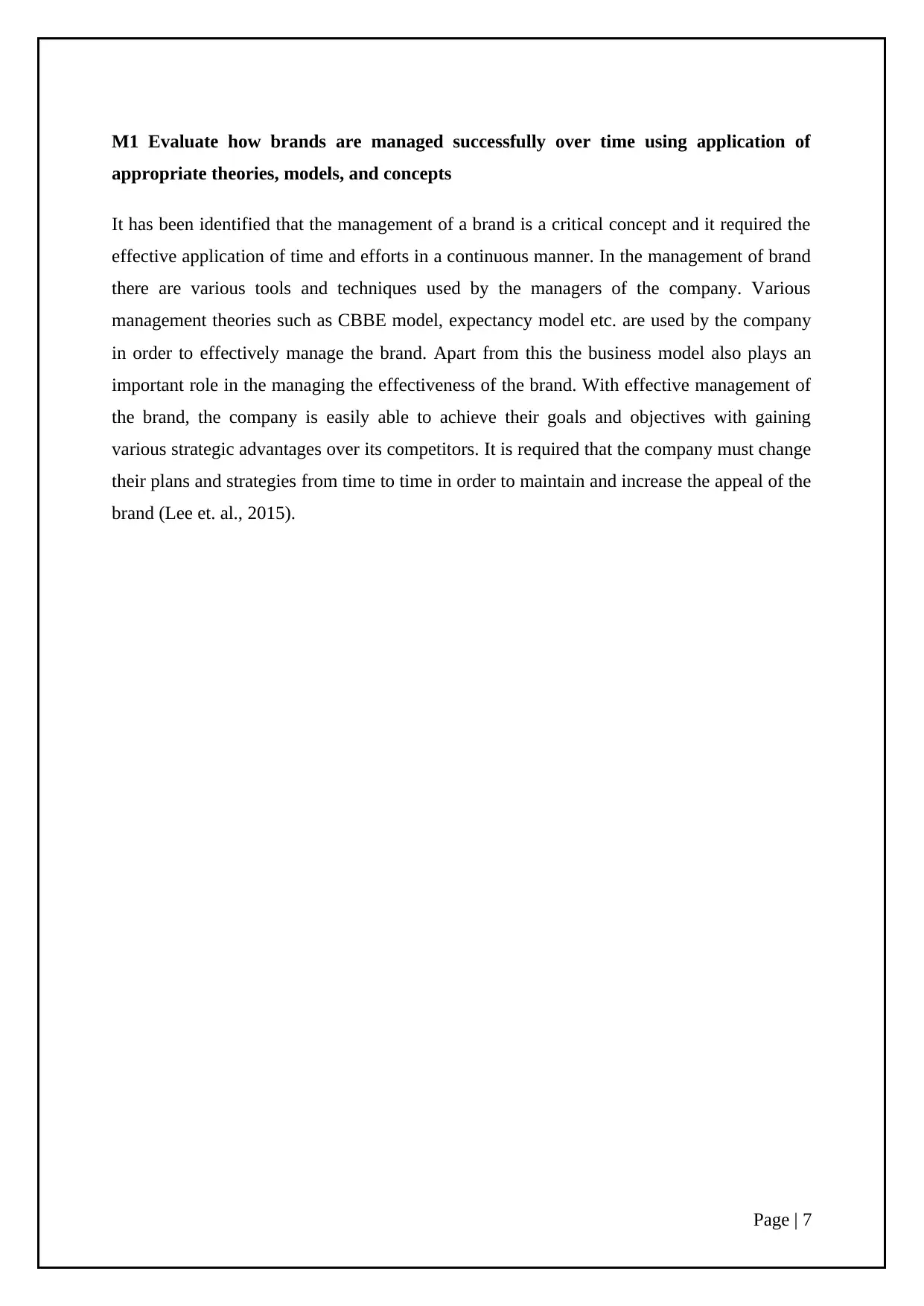
M1 Evaluate how brands are managed successfully over time using application of
appropriate theories, models, and concepts
It has been identified that the management of a brand is a critical concept and it required the
effective application of time and efforts in a continuous manner. In the management of brand
there are various tools and techniques used by the managers of the company. Various
management theories such as CBBE model, expectancy model etc. are used by the company
in order to effectively manage the brand. Apart from this the business model also plays an
important role in the managing the effectiveness of the brand. With effective management of
the brand, the company is easily able to achieve their goals and objectives with gaining
various strategic advantages over its competitors. It is required that the company must change
their plans and strategies from time to time in order to maintain and increase the appeal of the
brand (Lee et. al., 2015).
Page | 7
appropriate theories, models, and concepts
It has been identified that the management of a brand is a critical concept and it required the
effective application of time and efforts in a continuous manner. In the management of brand
there are various tools and techniques used by the managers of the company. Various
management theories such as CBBE model, expectancy model etc. are used by the company
in order to effectively manage the brand. Apart from this the business model also plays an
important role in the managing the effectiveness of the brand. With effective management of
the brand, the company is easily able to achieve their goals and objectives with gaining
various strategic advantages over its competitors. It is required that the company must change
their plans and strategies from time to time in order to maintain and increase the appeal of the
brand (Lee et. al., 2015).
Page | 7
Paraphrase This Document
Need a fresh take? Get an instant paraphrase of this document with our AI Paraphraser
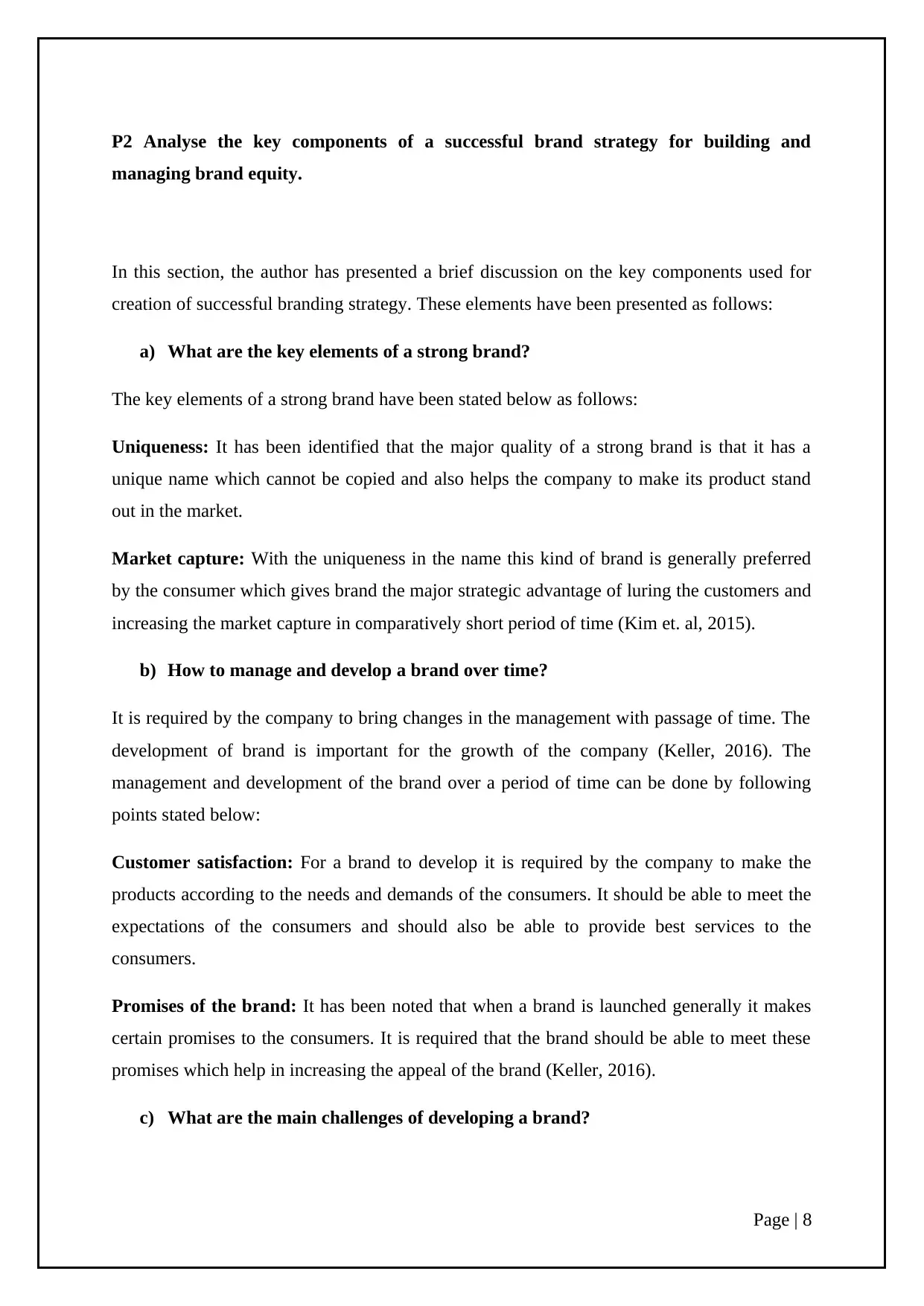
P2 Analyse the key components of a successful brand strategy for building and
managing brand equity.
In this section, the author has presented a brief discussion on the key components used for
creation of successful branding strategy. These elements have been presented as follows:
a) What are the key elements of a strong brand?
The key elements of a strong brand have been stated below as follows:
Uniqueness: It has been identified that the major quality of a strong brand is that it has a
unique name which cannot be copied and also helps the company to make its product stand
out in the market.
Market capture: With the uniqueness in the name this kind of brand is generally preferred
by the consumer which gives brand the major strategic advantage of luring the customers and
increasing the market capture in comparatively short period of time (Kim et. al, 2015).
b) How to manage and develop a brand over time?
It is required by the company to bring changes in the management with passage of time. The
development of brand is important for the growth of the company (Keller, 2016). The
management and development of the brand over a period of time can be done by following
points stated below:
Customer satisfaction: For a brand to develop it is required by the company to make the
products according to the needs and demands of the consumers. It should be able to meet the
expectations of the consumers and should also be able to provide best services to the
consumers.
Promises of the brand: It has been noted that when a brand is launched generally it makes
certain promises to the consumers. It is required that the brand should be able to meet these
promises which help in increasing the appeal of the brand (Keller, 2016).
c) What are the main challenges of developing a brand?
Page | 8
managing brand equity.
In this section, the author has presented a brief discussion on the key components used for
creation of successful branding strategy. These elements have been presented as follows:
a) What are the key elements of a strong brand?
The key elements of a strong brand have been stated below as follows:
Uniqueness: It has been identified that the major quality of a strong brand is that it has a
unique name which cannot be copied and also helps the company to make its product stand
out in the market.
Market capture: With the uniqueness in the name this kind of brand is generally preferred
by the consumer which gives brand the major strategic advantage of luring the customers and
increasing the market capture in comparatively short period of time (Kim et. al, 2015).
b) How to manage and develop a brand over time?
It is required by the company to bring changes in the management with passage of time. The
development of brand is important for the growth of the company (Keller, 2016). The
management and development of the brand over a period of time can be done by following
points stated below:
Customer satisfaction: For a brand to develop it is required by the company to make the
products according to the needs and demands of the consumers. It should be able to meet the
expectations of the consumers and should also be able to provide best services to the
consumers.
Promises of the brand: It has been noted that when a brand is launched generally it makes
certain promises to the consumers. It is required that the brand should be able to meet these
promises which help in increasing the appeal of the brand (Keller, 2016).
c) What are the main challenges of developing a brand?
Page | 8

It has been identified that in the process of the development of brand there are various
challenges faced by the company. Some of them are stated below as follows:
Trust of consumer: It has been identified that the loyalty and trust of consumers is
the main challenge of a brand. It is required that the brand should fulfill their
expectations to gain their trust.
Customer satisfaction: It is required by the company to develop the product
according to the needs and demands of the customers to ensure their satisfaction.
Competition: The competition in the market is high which makes it difficult for the
brand to prosper. Increasing competition is a major threat/ challenge to the
development of brand (Dinnie, 2015).
M2 Apply appropriate and validated examples within an organizational context.
Pizza Hut is a company which enjoys the perks and benefits of a strong brand. The main
focus of the company is on their quality and services which has helped the company to
develop an effective image of the brand in the market. The company offers a different and
unique combination of food items which help the company to attract its customers. Apart
from it, it has also been analysed that the company from time to time adds various
components in their products and brand which help in making the product appealing and also
helps the company to improve their product and service quality. Focusing on the consumer
trust is the motto of the organization which has helped the company in facing the competition
and has also helped in ensuring long-term sustainability (Dinnie, 2015).
Page | 9
challenges faced by the company. Some of them are stated below as follows:
Trust of consumer: It has been identified that the loyalty and trust of consumers is
the main challenge of a brand. It is required that the brand should fulfill their
expectations to gain their trust.
Customer satisfaction: It is required by the company to develop the product
according to the needs and demands of the customers to ensure their satisfaction.
Competition: The competition in the market is high which makes it difficult for the
brand to prosper. Increasing competition is a major threat/ challenge to the
development of brand (Dinnie, 2015).
M2 Apply appropriate and validated examples within an organizational context.
Pizza Hut is a company which enjoys the perks and benefits of a strong brand. The main
focus of the company is on their quality and services which has helped the company to
develop an effective image of the brand in the market. The company offers a different and
unique combination of food items which help the company to attract its customers. Apart
from it, it has also been analysed that the company from time to time adds various
components in their products and brand which help in making the product appealing and also
helps the company to improve their product and service quality. Focusing on the consumer
trust is the motto of the organization which has helped the company in facing the competition
and has also helped in ensuring long-term sustainability (Dinnie, 2015).
Page | 9
⊘ This is a preview!⊘
Do you want full access?
Subscribe today to unlock all pages.

Trusted by 1+ million students worldwide

Section 2
LO2 Analyse how brands are organised in portfolios; how brand hierarchies are built
and managed.
P3 Analyse different strategies of portfolio management, brand hierarchy, and brand
equity management.
In this segment of the report, the author has explained the strategy of brand portfolio
management taking into consideration the business strategy used by Pizza Hut and KFC in
the business environment of UK.
a) Brand Portfolio Strategy
Brand Portfolio Strategy can be identified as the tools and techniques that can be used by the
company such that company is able to generate and derive high amount of profits. Various
elements of branding are comprised of these strategies which can be used by the companies
in order to establish their product in the market (Aaker, 2014). Effective portfolio
management of the company can help company in addressing various issues such as:
What will be the perceived expectation and benefits that the consumers will get from
the brand?
How will the brand be able to sustain itself in the highly competitive market?
Various strategies of portfolio management used by McDonalds and Pizza Hut are specified
below as follows:
House of brand
The house of brand is a strategy of portfolio
management in which the application of
idea is to gain profits by the means of
investing a huge amount in the process of
brand management. The sub-brands that are
launched under the major brand are
determined as individual companies. The
main advantage of this is to present brand
The brand property model
On the other hand in the case of brand
property model the application of strategies
is done to all the brands of the company and
all the brands are considered as a single
unit. This strategy is used by Pizza Hut
which enables the company to manage
varied products at the same time. The major
advantage of this strategy is that it helps the
Page | 10
LO2 Analyse how brands are organised in portfolios; how brand hierarchies are built
and managed.
P3 Analyse different strategies of portfolio management, brand hierarchy, and brand
equity management.
In this segment of the report, the author has explained the strategy of brand portfolio
management taking into consideration the business strategy used by Pizza Hut and KFC in
the business environment of UK.
a) Brand Portfolio Strategy
Brand Portfolio Strategy can be identified as the tools and techniques that can be used by the
company such that company is able to generate and derive high amount of profits. Various
elements of branding are comprised of these strategies which can be used by the companies
in order to establish their product in the market (Aaker, 2014). Effective portfolio
management of the company can help company in addressing various issues such as:
What will be the perceived expectation and benefits that the consumers will get from
the brand?
How will the brand be able to sustain itself in the highly competitive market?
Various strategies of portfolio management used by McDonalds and Pizza Hut are specified
below as follows:
House of brand
The house of brand is a strategy of portfolio
management in which the application of
idea is to gain profits by the means of
investing a huge amount in the process of
brand management. The sub-brands that are
launched under the major brand are
determined as individual companies. The
main advantage of this is to present brand
The brand property model
On the other hand in the case of brand
property model the application of strategies
is done to all the brands of the company and
all the brands are considered as a single
unit. This strategy is used by Pizza Hut
which enables the company to manage
varied products at the same time. The major
advantage of this strategy is that it helps the
Page | 10
Paraphrase This Document
Need a fresh take? Get an instant paraphrase of this document with our AI Paraphraser
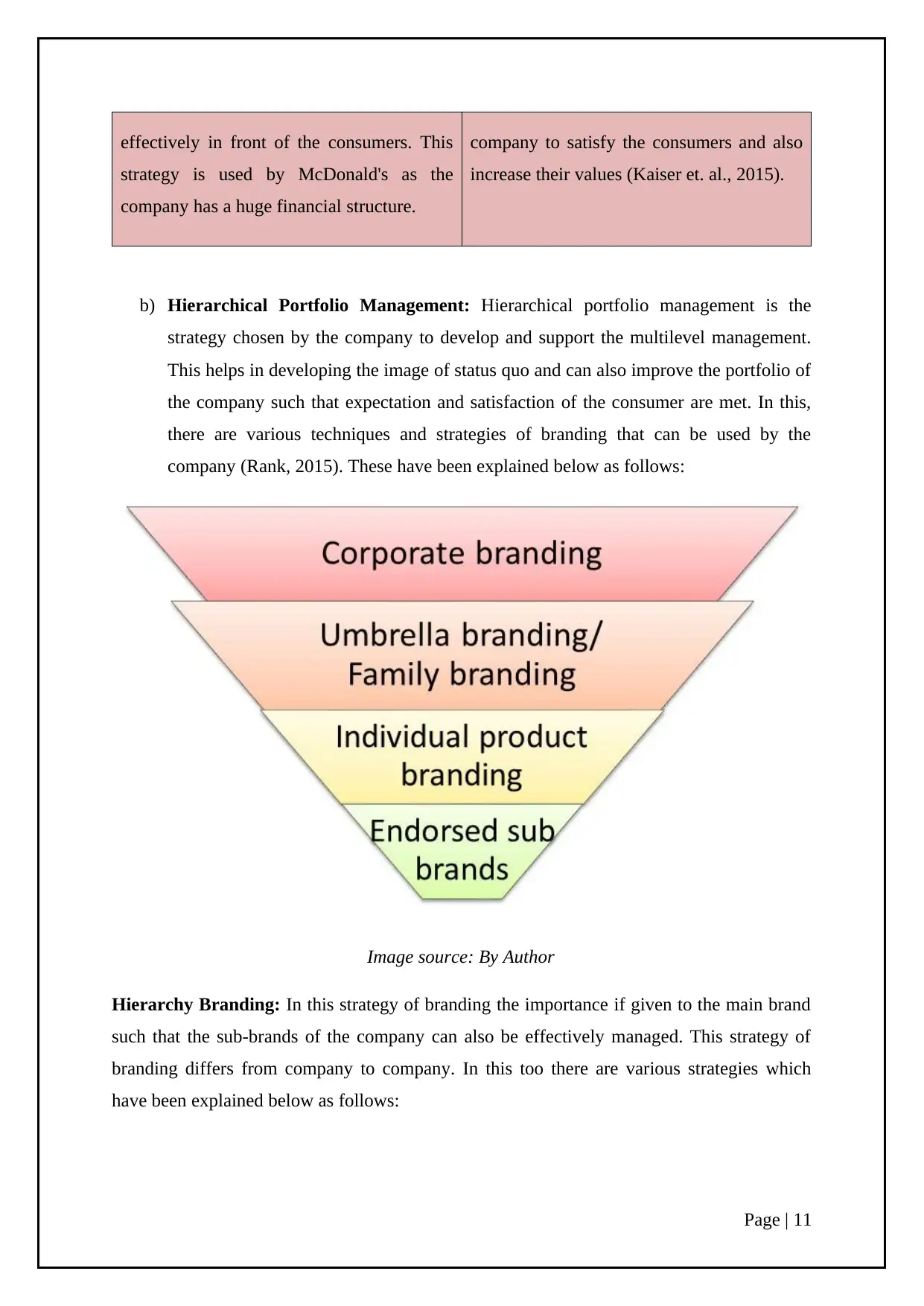
effectively in front of the consumers. This
strategy is used by McDonald's as the
company has a huge financial structure.
company to satisfy the consumers and also
increase their values (Kaiser et. al., 2015).
b) Hierarchical Portfolio Management: Hierarchical portfolio management is the
strategy chosen by the company to develop and support the multilevel management.
This helps in developing the image of status quo and can also improve the portfolio of
the company such that expectation and satisfaction of the consumer are met. In this,
there are various techniques and strategies of branding that can be used by the
company (Rank, 2015). These have been explained below as follows:
Image source: By Author
Hierarchy Branding: In this strategy of branding the importance if given to the main brand
such that the sub-brands of the company can also be effectively managed. This strategy of
branding differs from company to company. In this too there are various strategies which
have been explained below as follows:
Page | 11
strategy is used by McDonald's as the
company has a huge financial structure.
company to satisfy the consumers and also
increase their values (Kaiser et. al., 2015).
b) Hierarchical Portfolio Management: Hierarchical portfolio management is the
strategy chosen by the company to develop and support the multilevel management.
This helps in developing the image of status quo and can also improve the portfolio of
the company such that expectation and satisfaction of the consumer are met. In this,
there are various techniques and strategies of branding that can be used by the
company (Rank, 2015). These have been explained below as follows:
Image source: By Author
Hierarchy Branding: In this strategy of branding the importance if given to the main brand
such that the sub-brands of the company can also be effectively managed. This strategy of
branding differs from company to company. In this too there are various strategies which
have been explained below as follows:
Page | 11
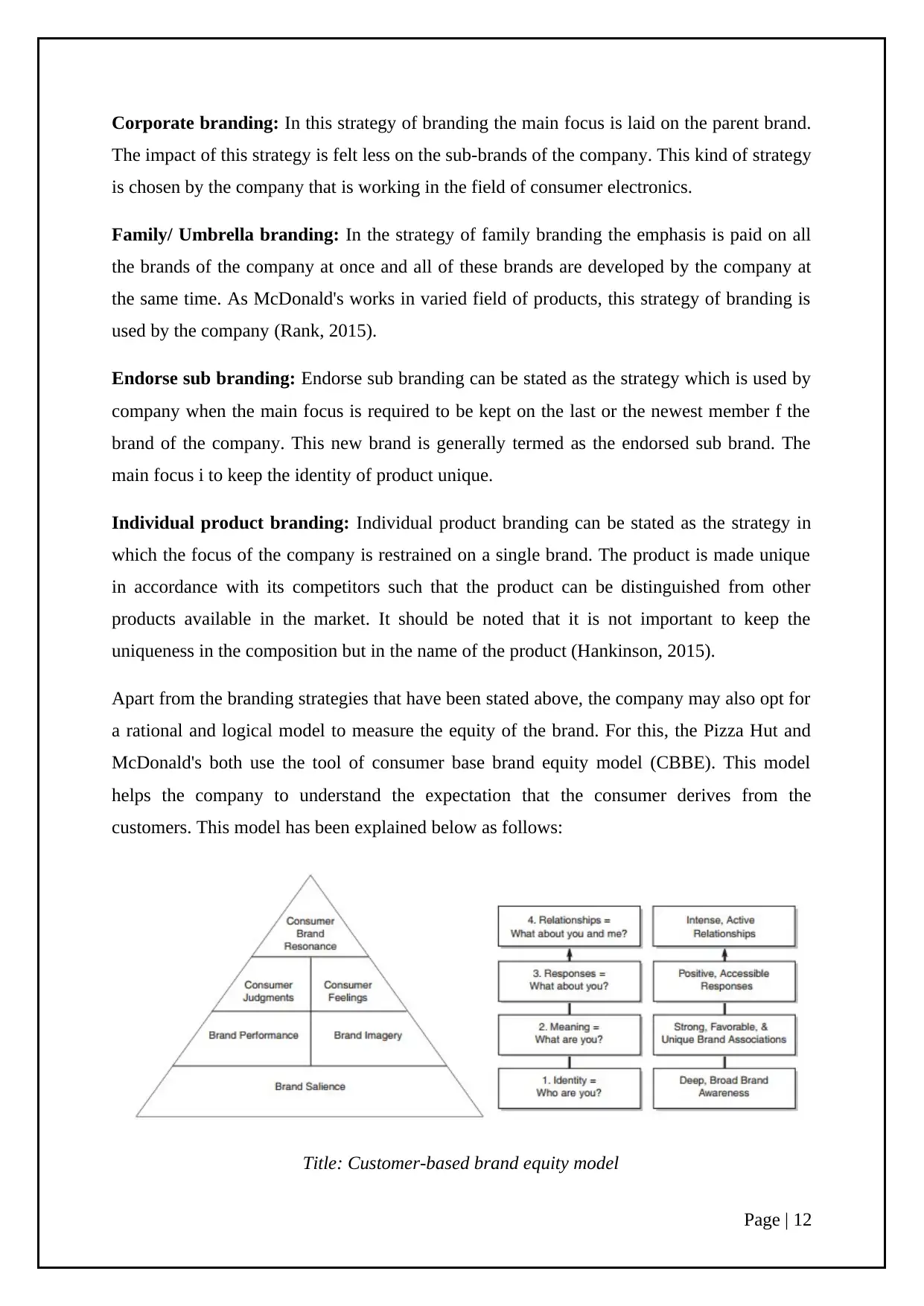
Corporate branding: In this strategy of branding the main focus is laid on the parent brand.
The impact of this strategy is felt less on the sub-brands of the company. This kind of strategy
is chosen by the company that is working in the field of consumer electronics.
Family/ Umbrella branding: In the strategy of family branding the emphasis is paid on all
the brands of the company at once and all of these brands are developed by the company at
the same time. As McDonald's works in varied field of products, this strategy of branding is
used by the company (Rank, 2015).
Endorse sub branding: Endorse sub branding can be stated as the strategy which is used by
company when the main focus is required to be kept on the last or the newest member f the
brand of the company. This new brand is generally termed as the endorsed sub brand. The
main focus i to keep the identity of product unique.
Individual product branding: Individual product branding can be stated as the strategy in
which the focus of the company is restrained on a single brand. The product is made unique
in accordance with its competitors such that the product can be distinguished from other
products available in the market. It should be noted that it is not important to keep the
uniqueness in the composition but in the name of the product (Hankinson, 2015).
Apart from the branding strategies that have been stated above, the company may also opt for
a rational and logical model to measure the equity of the brand. For this, the Pizza Hut and
McDonald's both use the tool of consumer base brand equity model (CBBE). This model
helps the company to understand the expectation that the consumer derives from the
customers. This model has been explained below as follows:
Title: Customer-based brand equity model
Page | 12
The impact of this strategy is felt less on the sub-brands of the company. This kind of strategy
is chosen by the company that is working in the field of consumer electronics.
Family/ Umbrella branding: In the strategy of family branding the emphasis is paid on all
the brands of the company at once and all of these brands are developed by the company at
the same time. As McDonald's works in varied field of products, this strategy of branding is
used by the company (Rank, 2015).
Endorse sub branding: Endorse sub branding can be stated as the strategy which is used by
company when the main focus is required to be kept on the last or the newest member f the
brand of the company. This new brand is generally termed as the endorsed sub brand. The
main focus i to keep the identity of product unique.
Individual product branding: Individual product branding can be stated as the strategy in
which the focus of the company is restrained on a single brand. The product is made unique
in accordance with its competitors such that the product can be distinguished from other
products available in the market. It should be noted that it is not important to keep the
uniqueness in the composition but in the name of the product (Hankinson, 2015).
Apart from the branding strategies that have been stated above, the company may also opt for
a rational and logical model to measure the equity of the brand. For this, the Pizza Hut and
McDonald's both use the tool of consumer base brand equity model (CBBE). This model
helps the company to understand the expectation that the consumer derives from the
customers. This model has been explained below as follows:
Title: Customer-based brand equity model
Page | 12
⊘ This is a preview!⊘
Do you want full access?
Subscribe today to unlock all pages.

Trusted by 1+ million students worldwide
1 out of 23
Related Documents
Your All-in-One AI-Powered Toolkit for Academic Success.
+13062052269
info@desklib.com
Available 24*7 on WhatsApp / Email
![[object Object]](/_next/static/media/star-bottom.7253800d.svg)
Unlock your academic potential
Copyright © 2020–2025 A2Z Services. All Rights Reserved. Developed and managed by ZUCOL.

